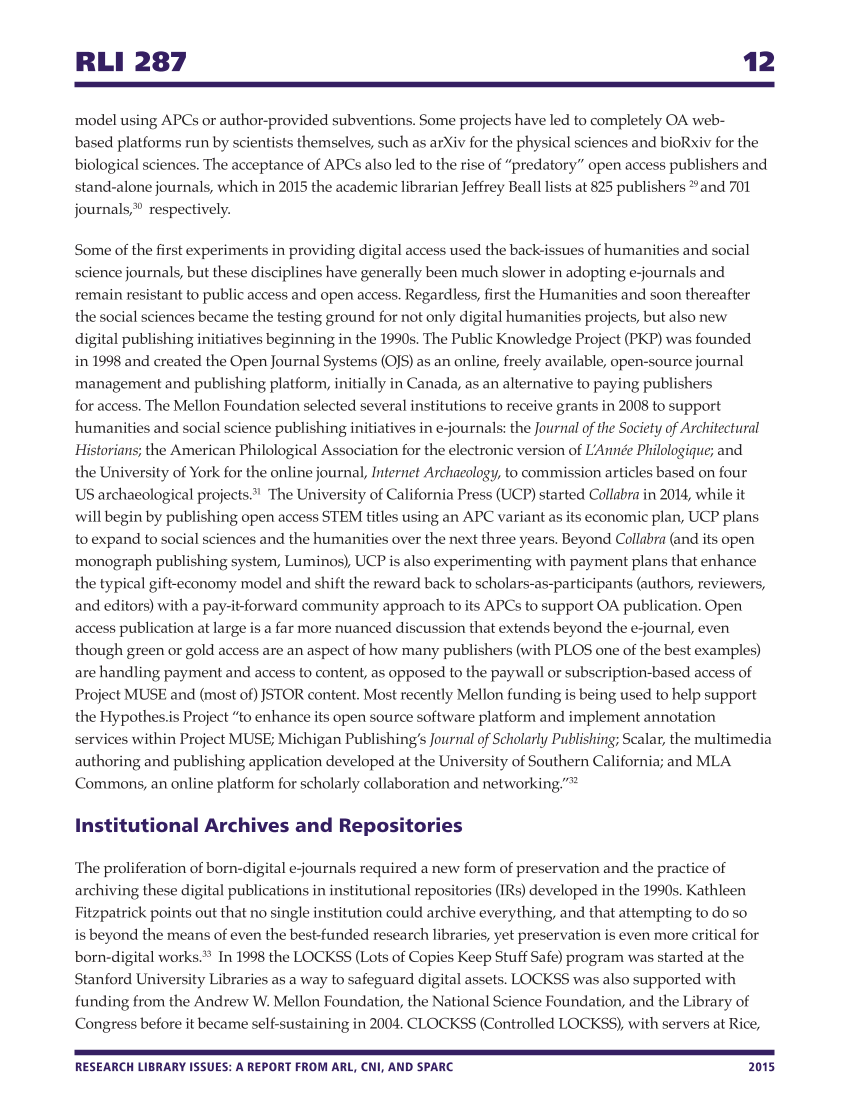RLI 287 12 RESEARCH LIBRARY ISSUES: A REPORT FROM ARL, CNI, AND SPARC 2015 model using APCs or author-provided subventions. Some projects have led to completely OA web- based platforms run by scientists themselves, such as arXiv for the physical sciences and bioRxiv for the biological sciences. The acceptance of APCs also led to the rise of “predatory” open access publishers and stand-alone journals, which in 2015 the academic librarian Jeffrey Beall lists at 825 publishers 29 and 701 journals,30 respectively. Some of the first experiments in providing digital access used the back-issues of humanities and social science journals, but these disciplines have generally been much slower in adopting e-journals and remain resistant to public access and open access. Regardless, first the Humanities and soon thereafter the social sciences became the testing ground for not only digital humanities projects, but also new digital publishing initiatives beginning in the 1990s. The Public Knowledge Project (PKP) was founded in 1998 and created the Open Journal Systems (OJS) as an online, freely available, open-source journal management and publishing platform, initially in Canada, as an alternative to paying publishers for access. The Mellon Foundation selected several institutions to receive grants in 2008 to support humanities and social science publishing initiatives in e-journals: the Journal of the Society of Architectural Historians the American Philological Association for the electronic version of L’Année Philologique and the University of York for the online journal, Internet Archaeology, to commission articles based on four US archaeological projects.31 The University of California Press (UCP) started Collabra in 2014, while it will begin by publishing open access STEM titles using an APC variant as its economic plan, UCP plans to expand to social sciences and the humanities over the next three years. Beyond Collabra (and its open monograph publishing system, Luminos), UCP is also experimenting with payment plans that enhance the typical gift-economy model and shift the reward back to scholars-as-participants (authors, reviewers, and editors) with a pay-it-forward community approach to its APCs to support OA publication. Open access publication at large is a far more nuanced discussion that extends beyond the e-journal, even though green or gold access are an aspect of how many publishers (with PLOS one of the best examples) are handling payment and access to content, as opposed to the paywall or subscription-based access of Project MUSE and (most of) JSTOR content. Most recently Mellon funding is being used to help support the Hypothes.is Project “to enhance its open source software platform and implement annotation services within Project MUSE Michigan Publishing’s Journal of Scholarly Publishing Scalar, the multimedia authoring and publishing application developed at the University of Southern California and MLA Commons, an online platform for scholarly collaboration and networking.”32 Institutional Archives and Repositories The proliferation of born-digital e-journals required a new form of preservation and the practice of archiving these digital publications in institutional repositories (IRs) developed in the 1990s. Kathleen Fitzpatrick points out that no single institution could archive everything, and that attempting to do so is beyond the means of even the best-funded research libraries, yet preservation is even more critical for born-digital works.33 In 1998 the LOCKSS (Lots of Copies Keep Stuff Safe) program was started at the Stanford University Libraries as a way to safeguard digital assets. LOCKSS was also supported with funding from the Andrew W. Mellon Foundation, the National Science Foundation, and the Library of Congress before it became self-sustaining in 2004. CLOCKSS (Controlled LOCKSS), with servers at Rice,


























